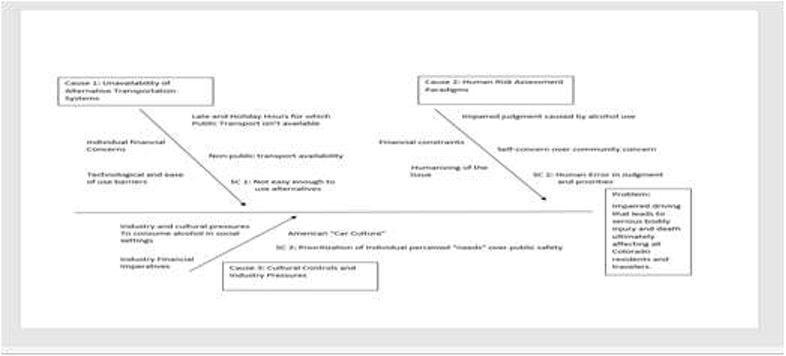Guest blog by Michelle Stone, IPP 2021
My expectations for the Public Policy Implementation course were to gain a broader perspective and strategies on how to implement sound public policy, with creative and innovative solutions. I wanted to learn how to engage and develop conversations even when various industry members’ perspectives are divergent while being cognizant of the changing dynamics in the marketplace, and the ability to adjust to industry and public concerns while collaborating with public health officials with an eye on public safety. I very much enjoyed working with our Formula 1 Team assignments and hearing about their public policy implementation goals, challenges, and progress with their implementation projects.

Participating in the Harvard Kennedy School, Public Policy Implementation course provided me with the security that the constant deconstruction of a policy problem statement is normal during the engagement and learning process. The creation of fishbone diagrams really allows innovative solutions around complex problems while being open to ideas brought up by the various team members and groups. I learned that challenges and roadblocks can also be opportunities for growth and a greater fostered understanding of the problem at hand and potential solutions to ideas I initially not considered
The implementation challenge I am working on is about minimizing impaired driving that leads to serious bodily injury or death ultimately affecting all Colorado residents and travelers to our state, while simultaneously disincentivizing unlawful financial assistance in liquor law between Manufacturers, Distributors, and on-premises retailers.

Our team started engaging in a constant dialogue with various liquor licensed entities and partner agencies and representatives including manufacturers, wholesalers, retailers, Mothers Against Drunk Driving, the Alcohol, Tobacco, Tax, and Trade Bureau (TTB), the Colorado Department of Transportation, Uber, and other state liquor regulators. Each conversation leads to new ideas and strategies but also opens the conversation up to a wider audience that I did not consider in my first fishbone diagram. These conversations lead to various stakeholders talking about the same problem but providing their unique perspectives and proposed solutions for this policy change. My biggest challenge right now is finding a way to invigorate Federal Regulators in updating 100-year-old liquor laws to 21st-century standards which may lead to further stated change and the ability of the liquor industries to provide funding for various sources of transportation in both urban and rural settings to decrease the number of DUI related accidents and fatalities in our state. Also, to be mindful of creating a conversation with the public about the social norming of consuming alcohol in every social setting from consuming during events ranging from sporting events to haircuts and buying furniture and clothing. How do we provide the public the ability to choose when to consume alcohol but inspire them not to get behind a wheel of a vehicle? People with substance abuse problems do not make the best choices, how do we work with this, do more marketing campaigns, and work with substance abuse counselors for ideas.
I was motivated by the interesting conversations and perspectives while developing solutions. For example, looking at the participation of the liquor industry, sports teams, and public and private transportation systems discussing how they could be a part of opportunities of awareness for the public while also providing funding for transportation surrounding sporting events and holidays to create an atmosphere where people can enjoy an alcoholic beverage while be provided with a mode of transportation so they do not drink and drive. Recently, Anheuser Busch, Uber, and Mothers Against Drunk Driving worked together to form a coalition that resulted in a widespread media blitz and campaign (“Decide to Ride”) aimed at reducing DUI fatalities on a nationwide scale.
Each lesson provided a great wealth of knowledge and experiences to think about. The PDIA took kit will be of significant help in my daily work as a liquor and tobacco regulator, but will also be heavily utilized when analyzing proposed legislation that impacts these industries, citizens of our state, and our division. I very much enjoyed the materials which talked about the concept of helping teams go beyond themselves by creating the conversation and influencing others to work together on this policy matter while being open to new ways of looking at the problem and being okay to adjust and change as more information was obtained and learned which ultimately leads to further change with small and big wins. I have been keeping track and reflecting daily on small wins within our organization, looking at what obstacles are holding us back, looking for solutions, and developing conversations with various partners for creative solutions within our everyday working environment both internally and externally.
My words of wisdom are to not be afraid to change your perspective or proposal along the way at any point of your policy plan, no matter how large or small the specific point of adjustment may be. We gather new, and more nuanced, information during every single conversation we have and from every single person, we encounter in our personal and professional lives. Any one of those conversations can change the entire course of your thinking on an issue, and that is not something to be ashamed of, but rather to reflect upon as a marvelous growth opportunity.
This is a blog series written by the alumni of the Implementing Public Policy Executive Education Program at the Harvard Kennedy School. Participants successfully completed this 6-month online learning course in 2021. These are their learning journey stories.
